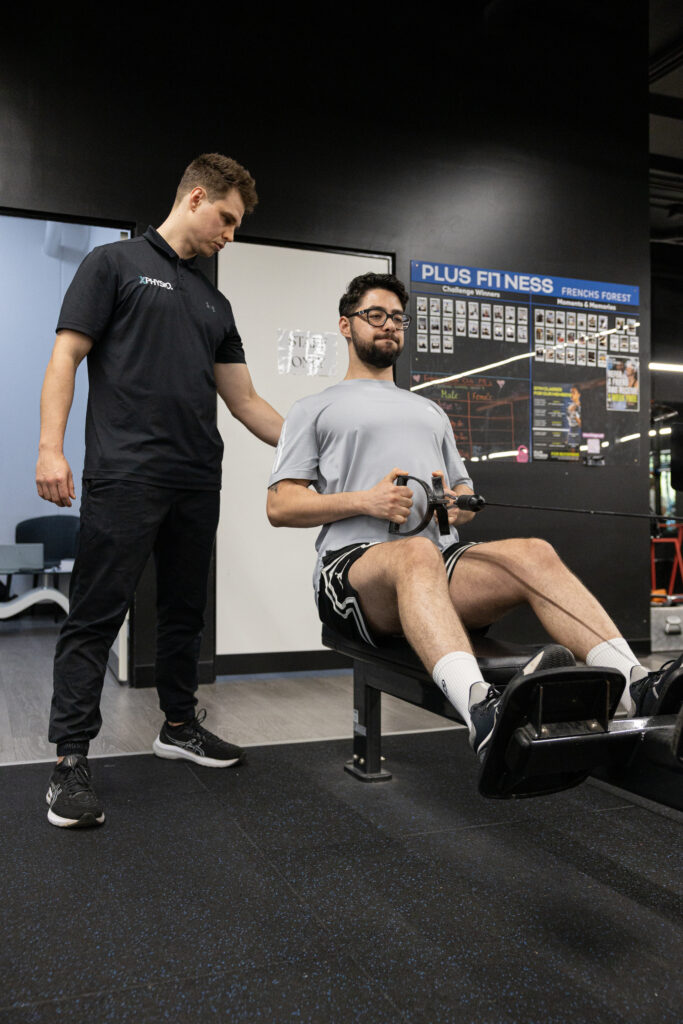
82) Physiotherapy for Neck and Shoulder Tension: Relieving Office Worker Pain
Neck and shoulder pain is one of the most common issues we see in office workers—usually caused by long hours at the desk, stress, and poor posture. The good news? Physiotherapy can ease tension quickly and help prevent it from creeping back. In this blog, we’ll unpack the real causes, the best treatments, and what actually works long-term.

The Modern Office Worker Problem: Why Neck and Shoulder Pain Happens
If you work at a desk, you’ve probably felt that familiar tightness creeping up your shoulders by mid-afternoon—or the stubborn knot at the base of your neck that just never goes away. You’re not alone. Neck and shoulder pain is now a leading musculoskeletal complaint among Australians working in corporate, healthcare, education, tech and hybrid roles.
The root cause? Usually a combination of these factors:
1. Prolonged sitting
Sitting still for hours causes upper back and neck muscles to fatigue. When they tire, the smaller muscles around the neck overwork and tighten.
2. Poor desk setup
A laptop placed too low or a monitor set too far away forces your head forward, placing huge stress on the cervical spine.
3. Stress and tension
Many office workers subconsciously “shrug” their shoulders when they’re stressed, which causes the upper trapezius muscles to stay switched on all day.
4. Forward-head posture
For every 2–3cm your head moves forward, the load on the neck muscles can double. Over time, this becomes chronic pain, stiffness and even headaches.
5. Reduced movement variety
Even if you have a “perfect” ergonomic setup, staying still too long is the real enemy. Movement is what keeps the muscles happy.
The good news? Physiotherapy directly targets each of these root causes and gives you real, lasting relief.

How Physiotherapy Helps Neck and Shoulder Pain
At X Physio in Frenchs Forest, we take a structured approach to reducing pain, improving mobility, and building long-term resilience. Here’s how physio helps:
1. Hands-on treatment for immediate relief
Manual therapy is one of the fastest ways to reduce tension and restore mobility. We commonly use:
- Soft tissue release
- Trigger point therapy
- Joint mobilisation
- Dry needling (when appropriate)
These hands-on techniques reduce muscle guarding, improve circulation, and help the nervous system down-regulate its pain response.
2. Restoring movement and mobility
When the neck and shoulders stop moving well, everything stiffens up. Physiotherapy helps restore:
- Cervical rotation (turning the head)
- Thoracic extension (straightening the upper back)
- Scapular (shoulder blade) movement
- Rib mobility
Even small mobility improvements can dramatically reduce daily pain levels.
3. Strengthening the right muscles
Tight muscles are often weak muscles simply working overtime. Strengthening key areas reduces load on irritated tissues:
- Deep neck flexors
- Lower trapezius
- Serratus anterior
- Rotator cuff
- Thoracic extensors
You don’t need a gym for this—most exercises are simple, low-load movements perfect for home or the office.

4. Posture coaching (but not the outdated kind)
Posture is not about sitting “perfectly straight”—it’s about staying adaptable. We help you:
- Adjust your workstation ergonomics
- Learn micro-break strategies
- Understand what “good movement variety” looks like
- Reduce tension habits (like shrugging or clenching)
Our goal is to help you move more, not sit still in a rigid position.
5. Stress and tension management strategies
Many cases of neck and shoulder pain are linked to stress. We integrate simple, practical strategies such as:
- Breathing control
- Relaxation techniques
- Gentle mobility routines you can use between meetings
These help calm the nervous system so it stops amplifying your pain signals.
6. Preventing flare-ups
One of the strongest benefits of physiotherapy is learning how to stop pain coming back.
We work with you to:
- Identify your individual triggers
- Build strength and mobility in weak links
- Create a personalised home plan
- Gradually increase your tolerance to sitting, work and exercise
Long-term success is all about consistency—not perfection.
A Real Example: Patient Success Story from a Nearby Suburb
Recently, we treated Courtney, a 37-year-old accountant from Dee Why, who came in with persistent neck and shoulder pain that had been bothering her for almost 18 months. She worked mostly from home and noticed the pain was worst during busy periods when she barely left her desk.
She reported:
- Tightness across the top of both shoulders
- Frequent tension headaches
- A pulling sensation when she turned her head
- Pain when lifting her children into the car
- Difficulty concentrating by the afternoon
After a detailed assessment, we identified:
- Reduced cervical rotation
- Overactive upper trapezius muscles
- Weak deep neck flexors
- Limited thoracic mobility
- A poorly adjusted home office setup
Her Treatment Plan Included:
- Hands-on release to her upper traps and neck muscles
- Thoracic joint mobilisation
- Dry needling to reduce stubborn muscle guarding
- A personalised strengthening program
- A few simple ergonomic changes
- A “2-minute mobility break” routine for work days
The Result?
By the third session, her pain had reduced by 60%.
By week four, she reported her first “completely pain-free workday in over a year”.
By week six, she was confidently exercising again and hadn’t experienced another headache.
This is a typical outcome when treatment is targeted, consistent, and based on the root cause—not just the symptoms.
The Link Between Neck Pain, Shoulder Pain and Headaches
Many office workers don’t realise that their headaches are often coming from their neck. This is called cervicogenic headache, and it happens when tightened cervical muscles refer pain upwards.
Signs your headaches are neck-related include:
- Pain that starts in the neck or base of the skull
- Headaches triggered by work or sitting
- Soreness when pressing along the neck muscles
- Reduced neck movement
- Pain on one side of the head
Physiotherapy is extremely effective at treating this type of headache because it treats the source—not just the pain.

Best Exercises for Neck and Shoulder Tension
Here are a few office-friendly exercises that help reduce pain and tightness. These should be performed gently and consistently:
1. Chin tucks (deep neck flexor activation)
Strengthens the muscles that support the neck and improve alignment.
2. Scapular retraction
Helps balance the overactive shoulder muscles.
3. Thoracic extension over a rolled towel
Releases stiffness in the upper back.
4. Upper trapezius and levator scapulae stretches
Relieves the most common tension areas.
5. Shoulder external rotation strengthening
Supports shoulder blade control and reduces load on the neck.
We provide personalised exercise programs based on your specific assessment—not generic templates.

How Long Does It Take to Improve Neck and Shoulder Pain?
Most patients feel noticeably better within 2–3 sessions, especially with the right combination of hands-on treatment and tailored exercises.
Chronic cases may require 12 weeks to fully restore strength, mobility, and postural control.
The key factor in long-term success is consistency with your exercises and movement habits.
Should You See a Physiotherapist or Just Stretch?
Stretching feels good—but it rarely solves the underlying issue on its own.
If your pain:
- Keeps returning
- Affects your sleep
- Causes headaches
- Limits your movement
- Interferes with work or gym
- Has lasted more than 2 weeks
…it’s time for a proper physiotherapy assessment.
A physio can pinpoint the exact structure causing your pain and tailor your treatment properly.
When Neck and Shoulder Pain Becomes More Serious
While most cases are mechanical and easily treatable, seek assessment if you experience:
- Numbness or tingling into the arms
- Weakness in the hands
- Severe pain that appears suddenly
- Pain following an accident
- Persistent headaches or dizziness
These symptoms may indicate nerve involvement or other conditions requiring targeted care.

FAQs About Neck and Shoulder Pain (with Schema Markup Below)
1. What causes neck and shoulder pain in office workers?
Neck and shoulder pain is often caused by poor posture, prolonged sitting, muscle fatigue, stress, and reduced movement. Over time these factors overload the neck and upper back muscles, leading to stiffness and pain.
2. How can physiotherapy help with neck and shoulder tension?
Physiotherapy helps by reducing muscle tightness, restoring movement, improving posture, and strengthening the muscles that support your neck and shoulders. Treatment includes hands-on therapy, exercises, ergonomic advice and strategies to prevent recurrence.
3. How long does it take to see results from physio?
Most patients feel improvement within 1–3 sessions, depending on the severity of the issue. Chronic or long-standing pain may take several weeks to fully resolve.
4. Can office ergonomics really make a difference?
Yes. A properly set-up workstation can significantly reduce stress on your neck and shoulders. Even small adjustments to monitor height, chair support, or keyboard position can reduce tension.
5. Do I need imaging for neck and shoulder pain?
Not usually. Most office-related neck and shoulder pain is mechanical and responds well to physiotherapy without the need for scans.
References
- X Physio Blog – https://xphysio.com.au/blog/
- Australian Physiotherapy Association
- https://ergonomics.org.au/Ergonomics Australia
Ready to Fix Your Neck and Shoulder Pain?
Don’t let daily tension or office stress control your life.
Give us a call today on 9806 3077, or book online — just CLICK HERE:
https://x-physio.au4.cliniko.com/bookings#service
{
“@context”: “https://schema.org”,
“@type”: “FAQPage”,
“mainEntity”: [
{
“@type”: “Question”,
“name”: “What causes neck and shoulder pain in office workers?”,
“acceptedAnswer”: {
“@type”: “Answer”,
“text”: “Neck and shoulder pain is usually caused by poor posture, prolonged sitting, muscle fatigue, stress, and limited movement, which overload the neck and upper back muscles.”
}
},
{
“@type”: “Question”,
“name”: “How can physiotherapy help with neck and shoulder tension?”,
“acceptedAnswer”: {
“@type”: “Answer”,
“text”: “Physiotherapy helps reduce muscle tightness, restore mobility, improve posture and strengthen supporting muscles through hands-on treatment, exercises and ergonomic advice.”
}
},
{
“@type”: “Question”,
“name”: “How long does it take to see results from physio?”,
“acceptedAnswer”: {
“@type”: “Answer”,
“text”: “Most patients feel improvement within 1–3 sessions, while chronic cases may take several weeks depending on the severity and contributing factors.”
}
},
{
“@type”: “Question”,
“name”: “Can office ergonomics really make a difference?”,
“acceptedAnswer”: {
“@type”: “Answer”,
“text”: “Yes. Correct ergonomic setup reduces strain on the neck and shoulders by improving posture and decreasing muscle fatigue.”
}
},
{
“@type”: “Question”,
“name”: “Do I need imaging for neck and shoulder pain?”,
“acceptedAnswer”: {
“@type”: “Answer”,
“text”: “In most cases, no. Office-related neck and shoulder pain typically responds well to physiotherapy without the need for scans.”
}
}
]
}



